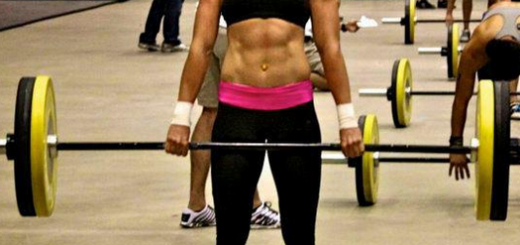CrossFitters are talking about the pelvic floor! Not surprisingly, the CrossFit world became atwitter with Emily Beers’ brave work in the March 2013 article, “From Crunches to Climax,” where she introduced the rest of us to the phenomenon of exercise-induced orgasms experienced by a handful of women during certain abdominal exercises. In June 2013, Rory McKernan let the cat out of the bag when he coaxed several high-level female athletes, one gynecologist, and one half-seriousFroning, to admit that they pee during tough workouts, which is a sign of stress incontinence. This is a dirty little not-so-secret secret of CrossFit. I became aware of this phenomenon a few months into my CrossFit journey and just thought it was something that “us mommies” had to learn to live with. I quickly learned, however, that this issue doesn’t plague just “us mommies.” Fit, fabulous, and BC (before children!) women were all slyly admitting to this piddle pattern. What gives? Fast forward a year and a half into chasing a doctorate in physical therapy and I met Cindy Furey, a physical therapist who specializes in pelvic floor function. Her presentation changed up my game of thrones and armed me with some tools to help prevent the puddles.Through this article, I hope to convey to the readers what the normal functions of the pelvic floor muscles are, their importance, and an easy-to-follow plan for how to keep them from going to pot (pun intended). Before we can talk about how to address this inconvenient issue, however, we need to identify what is normal.
- Urinating every 2-5 hours
- Urinating 4-5 times a day for men or 5-7 times a day for women
- Waking 0-2 times a night to urinate
- Controllable urges with the ability to postpone for 30 min to 2 hours
- MINIMAL time of urine stream = 8-10 seconds
- NORMAL time of urine stream = 20-30 sec
- Relaxed/seated voiding
- NO LEAKING
I know that some of you are laughing (and leaking while you laugh) at these “normal” values. As we saw on the video with Rory, even the gynecologist reports that peeing during a workout is “ok.” As I learned from Cindy, peeing during a workout (double-unders included) is definitely common but definitely NOT NORMAL. So let’s work towards a solution.
A Brief Anatomy Lesson

First things first. What are we actually dealing with here? The pelvic floor has five main functions:
- supporting the organs
- providing somewhat of a sump-pump effect for the lower trunk
- sphincteric control (you want this — you really, really want this)
- sexual function (yay!) and
- providing stability.
If you’re not sure where they are, a good way to find them (not to strengthen them, just to figure out where they are) is to try to stop the flow of your urine when you’re on the potty next time. The muscles that are responsible for stopping the flow are also responsible for all of the functions I mention above. Interestingly, men and women have very similar pelvic floor muscle designs and functions with men missing a distinguishing anatomical opening. Now that we briefly covered anatomy, it’s business time. Here are some things that I currently believe will help anyone with a pelvis to reduce incontinence, reduce inconvenience, and maybe even improve sexual performance (hooray!), or set a deadlift PR.
Sit in Neutral Spine
You’re probably sitting as you read this. What are you sitting on? Sure, your butt. But what part? Chances are, despite the 522+ videos of positional goodness produced by the prolific Kelly Starrett, you’re in sacral sitting. You lost your solid, braced position and have fallen back into the chair resting on your sacrum. Other than trashing your spine, what’s the big deal? The big deal is that your little pelvic floor muscles are supporting all of your guts while you’re in sacral sitting. Now that you’re sitting up straight (hopefully after a correct bracing sequence) in a more neutral pelvic alignment, your pelvis literally lightens the load for your pelvic floor muscles. How would you ever expect any muscle to “perform” if you never allowed it an opportunity to relax? You wouldn’t. You’d give your legs a rest day. You’d back off from overhead movements for a day or so. But most of us don’t see the importance of allowing the pelvic floor muscles to take a breather until now.
Game of Thrones: Sit Down to Pee
Again, most of you are laughing at reading this, especially my mommy friends. Yes, I’ve seen plenty of bathrooms at plenty of boxes and they are in various states of cleanliness. I’ve been a Marine officer for 11 years, so I’ve seen my fair share of downright gross toilets. We’re going to need to get over this one culturally if we don’t want to start wearing adult diapers in our WODs. Put the toilet paper down on the toilet seat. Use the rice-paper like cover that you usually only use as a back-up for TP when you find the stall is not well-stocked. Enjoy the bareback experience in your own home and sit down to pee or, if you’re a dude, stand, but stand in a relaxed manner and go with the flow. Remember those “normal” values of how long it should take to pee? Many of us are so ingrained that we “hover” and 3…2…1…go! Urinating becomes a timed event and we attempt to force out the pee as quickly as possible. There are several problems with this approach:
- It’s actually NOT a race, so sit down and take the 20-30 seconds to pee while you’re scrolling through your Instagram feed.
- It confuses the pelvic floor! You need to relax the pelvic floor in order to pee, but standing — particularly “hovering” — activates the pelvic floor to contract. A recent study discovered that the pelvic floor muscles are activated indirectly by the anatomically nearby obturator internus, a hip external rotator (remember that, we’re coming back to that). Hovering over the toilet activates the hip external rotators and in turn activates the pelvic floor. So they get confused: contract or not to contract? As falling over would be more immediately dangerous, the pelvic floor shorts itself of the sphincteric control and closes down the urine stream before you’re truly done and you end up with a little left in the tank even after voiding. This sets us up for leaking and for going to the bathroom more frequently than 5-7 times a day.










